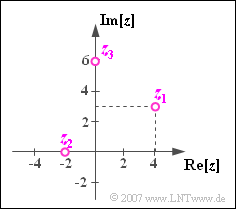Exercise 1.3Z: Calculating with Complex Numbers II
From LNTwww
The following three complex quantities are shown in the complex plane to the right:
- $$z_1 = 4 + 3\cdot {\rm j},$$
- $$ z_2 = -2 ,$$
- $$z_3 = 6\cdot{\rm j} .$$
Within the framework of this task, the following quantities are to be calculated:
- $$z_4 = z_1 \cdot z_1^{\star},$$
- $$z_5 = z_1 + 2 \cdot z_2 - {z_3}/{2},$$
- $$z_6 = z_1 \cdot z_2,$$
- $$z_7 = {z_3}/{z_1}.$$
Hints:
- This exercise belongs to the chapter Calculating with Complex Numbers.
- The topic of this task is also covered in the (German language) learning video
Rechnen mit komplexen Zahlen ⇒ "Arithmetic operations involving complex numbers". - Enter the phase values in the range of $-\hspace{-0.05cm}180^{\circ} < \phi ≤ +180^{\circ}$.
Questions
Solution
(1) The magnitude can be calculated according to the Pythagorean theorem:
- $$|z_1| = \sqrt{x_1^2 + y_1^2}= \sqrt{4^2 + 3^2}\hspace{0.15cm}\underline{ = 5}.$$
- For the phase angle, the following applies according to the page Darstellung nach Betrag und Phase :
- $$\phi_1 = \arctan \frac{y_1}{x_1}= \arctan \frac{3}{4}\hspace{0.15cm}\underline{ = 36.9^{\circ}}.$$
(2) Multiplying $z_1$ by its conjugate complex $z_1^{\star}$ yields the purely real quantity $z_4$, as the following equations show:
- $$z_4 = (x_1 + {\rm j} \cdot y_1)(x_1 - {\rm j} \cdot y_1)= {x_1^2 + y_1^2}= |z_1|^2 = 25,$$
- $$z_4 = |z_1| \cdot {\rm e}^{{\rm j}\hspace{0.05cm} \cdot \hspace{0.05cm}\phi_1} \cdot |z_1| \cdot {\rm e}^{-{\rm j} \hspace{0.05cm} \cdot \hspace{0.05cm} \phi_1}= |z_1|^2 = 25\hspace{0.3cm} \Rightarrow\hspace{0.3cm} x_4 \hspace{0.1cm}\underline{= 25}, \hspace{0.25cm}y_4 \hspace{0.15cm}\underline{= 0}.$$
(3) By dividing into real and imaginary part one can write:
- $$x_5 = x_1 + 2 \cdot x_2 - {x_3}/{2} = 4 + 2 \cdot(-2) -0 \hspace{0.15cm}\underline{= 0},$$
- $$y_5 = y_1 + 2 \cdot y_2 - {y_3}/{2} = 3 + 2 \cdot 0 - \frac{6}{2} \hspace{0.1cm}\underline{=0}.$$
(4) If one writes $z_2$ as magnitude and phase ⇒ $|z_2| = 2, \ \phi_2 = 180^{\circ}$, one obtains for the product:
- $$|z_6| = |z_1| \cdot |z_2|= 5 \cdot 2 \hspace{0.15cm}\underline{= 10},$$
- $$\phi_6 = \phi_1 + \phi_2 = 36.9^{\circ} + 180^{\circ} = 216.9^{\circ}\hspace{0.15cm}\underline{= -143.1^{\circ}}.$$
(5) The phase is $\phi_3 = 90^{\circ}$ (see graph above). This can be formally proven:
- $$\phi_3 = \arctan \left( \frac{6}{0}\right) = \arctan (\infty) \hspace{0.2cm}\Rightarrow \hspace{0.2cm} \phi_3 \hspace{0.15cm}\underline{= 90^{ \circ}}.$$
(6) First, the more inconvenient solution:
- $$z_7 = \frac{z_3}{z_1}= \frac{6{\rm j}}{4 + 3{\rm j}} = \frac{6{\rm j}\cdot(4 - 3{\rm j})}{(4 + 3{\rm j})\cdot (4 - 3{\rm j})} = \frac{18 +24{\rm j}}{25} = 1.2 \cdot{\rm e}^{{\rm j} \hspace{0.05cm}\cdot \hspace{0.05cm} 53.1^{ \circ}}.$$
- An easier way of solving the problem is:
- $$|z_7| = \frac{|z_3|}{|z_1|} = \frac{6}{5}\hspace{0.15cm}\underline{=1.2}, \hspace{0.3cm}\phi_7 = \phi_3 - \phi_1 = 90^{\circ} - 36.9^{\circ} \hspace{0.15cm}\underline{=53.1^{\circ}}.$$
